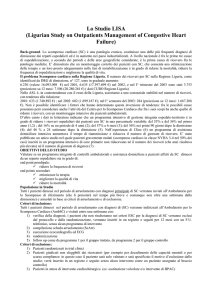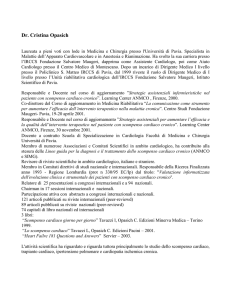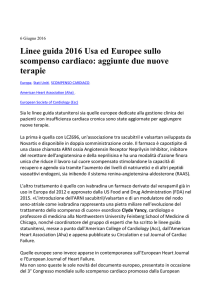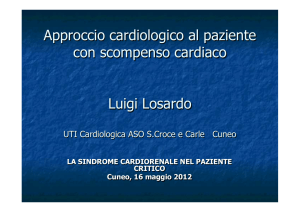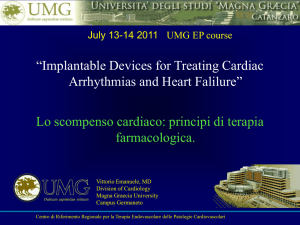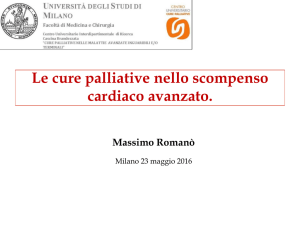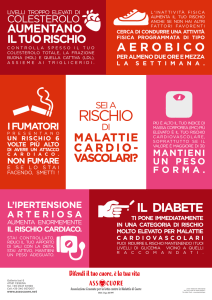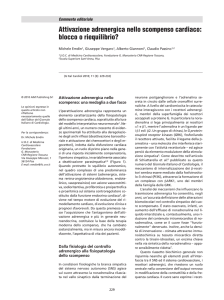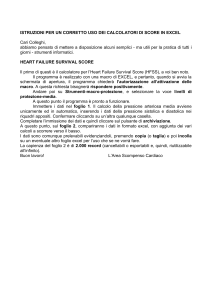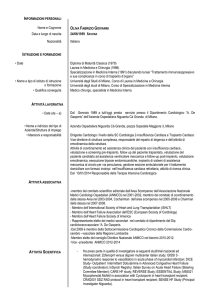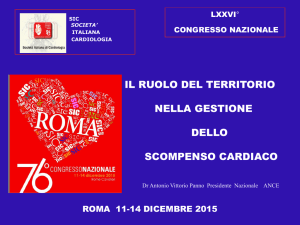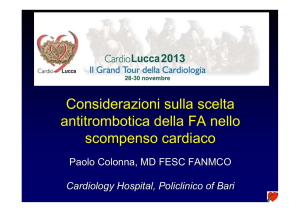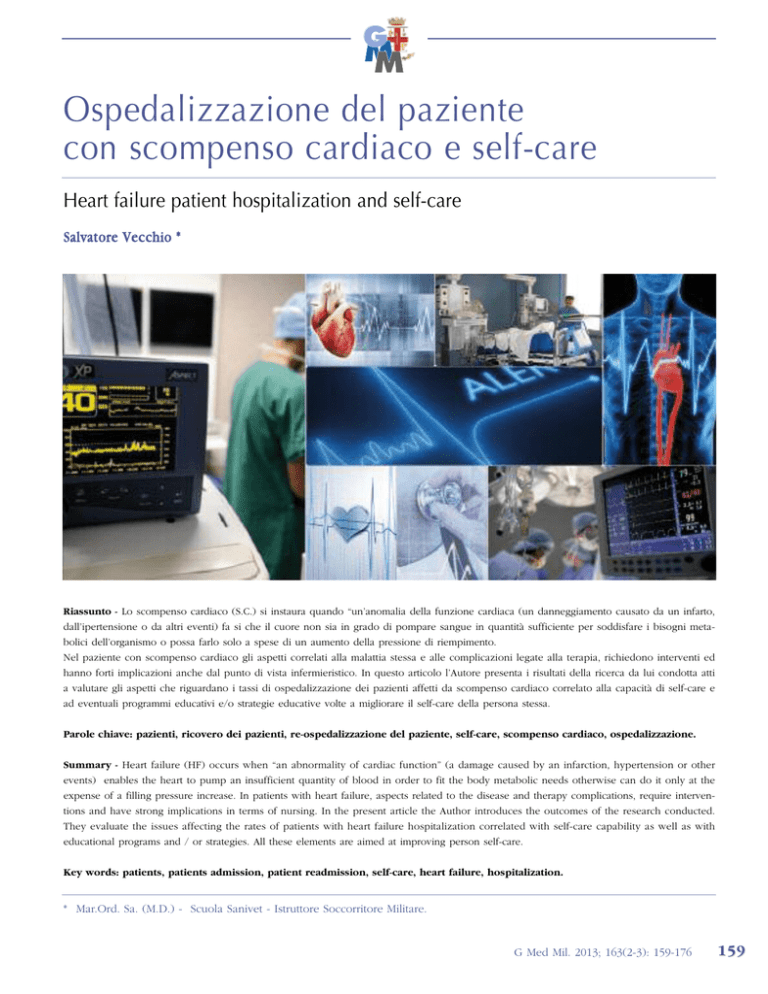
G
M
M
Ospedalizzazione del paziente
con scompenso cardiaco e self-care
Heart failure patient hospitalization and self-care
Salvatore Vecchio *
Riassunto - Lo scompenso cardiaco (S.C.) si instaura quando “un’anomalia della funzione cardiaca (un danneggiamento causato da un infarto,
dall’ipertensione o da altri eventi) fa si che il cuore non sia in grado di pompare sangue in quantità sufficiente per soddisfare i bisogni metabolici dell’organismo o possa farlo solo a spese di un aumento della pressione di riempimento.
Nel paziente con scompenso cardiaco gli aspetti correlati alla malattia stessa e alle complicazioni legate alla terapia, richiedono interventi ed
hanno forti implicazioni anche dal punto di vista infermieristico. In questo articolo l’Autore presenta i risultati della ricerca da lui condotta atti
a valutare gli aspetti che riguardano i tassi di ospedalizzazione dei pazienti affetti da scompenso cardiaco correlato alla capacità di self-care e
ad eventuali programmi educativi e/o strategie educative volte a migliorare il self-care della persona stessa.
Parole chiave: pazienti, ricovero dei pazienti, re-ospedalizzazione del paziente, self-care, scompenso cardiaco, ospedalizzazione.
Summary - Heart failure (HF) occurs when “an abnormality of cardiac function” (a damage caused by an infarction, hypertension or other
events) enables the heart to pump an insufficient quantity of blood in order to fit the body metabolic needs otherwise can do it only at the
expense of a filling pressure increase. In patients with heart failure, aspects related to the disease and therapy complications, require interventions and have strong implications in terms of nursing. In the present article the Author introduces the outcomes of the research conducted.
They evaluate the issues affecting the rates of patients with heart failure hospitalization correlated with self-care capability as well as with
educational programs and / or strategies. All these elements are aimed at improving person self-care.
Key words: patients, patients admission, patient readmission, self-care, heart failure, hospitalization.
* Mar.Ord. Sa. (M.D.) - Scuola Sanivet - Istruttore Soccorritore Militare.
G Med Mil. 2013; 163(2-3): 159-176
159
G
M
M
Introduzione
• Classe A: pazienti ad alto rischio
mente superiore nei pazienti meno
sviluppo di SC per la presenza di
anziani (<65 anni: ⇔3.506) mentre è infe-
L’incapacità del cuore a soddisfare i
condizioni strettamente correlate.
riore (⇔3.199) nei pazienti di 65 anni e
fabbisogni tessutali può essere dovuta a
Questi pazienti non hanno storia
oltre. (Ministero della Salute, 2007)
riempimento inefficace e insufficiente e/o
clinica di cardio-miopatie e scom-
ad un’anomala contrazione e successivo
penso cardiaco.
svuotamento. (Braunwald E., et al., 2007).
• Classe B: pazienti che hanno svilup-
logia sono ancor più considerevoli se si
Lo scompenso cardiaco è una
pato cardiopatie strutturali stretta-
tiene conto del processo di invecchia-
sindrome caratterizzata da una scadente
mente correlate con l’insorgenza di
mento che affligge le società industrializ-
qualità di vita (QdV), alti tassi di ospe-
scompenso
zate, e che determina non tanto un incre-
cardiaco
ma
senza
presentarne segni e sintomi.
dalizzazione ed una prognosi sfavore-
mento dell’incidenza del fenomeno bensì
• Classe C: pazienti che presentano o
un aumento della sua prevalenza, che,
Sono stati sviluppati diversi approcci
che hanno avuto sintomi di scom-
secondo uno studio epidemiologico sullo
volti a classificare e gestire in maniera
penso cardiaco associati a cardiopatie
scompenso cardiaco condotto nel 2004,
strutturali sottostanti.
cresce drasticamente ed aumenta con l’au-
vole. (Edner M., et al., 2004).
migliore questa sindrome di notevole
complessità.
• Classe D: pazienti con cardiopatie
mentare dell’età (il 9.1% delle persone di
Il sistema di classificazione maggior-
strutturali avanzate e marcati sintomi
età > di 80 anni). (Rengo, F., et al., 2004)
mente osservato in letteratura è quello
di scompenso cardiaco a riposo
Secondo lo stesso studio, infatti, lo
realizzato dalla New York Heart Asso-
malgrado una terapia medica massi-
scompenso cardiaco rappresenta una
ciation (NYHA), una classificazione
male e che richiedono interventi
sindrome tipica dell’anziano (età media
funzionale che tiene conto del livello di
specialistici (Hunt, SA., et al., 2001).
dei pazienti affetti 74 anni) e viene
limitazione all’espletamento delle attività
Dato che circa 10 milioni di persone
pertanto definita, anche in virtù della
quotidiane che la sindrome comporta
risultano affette da scompenso cardiaco
sua complessità e divergenza rispetto
nei soggetti affetti, come segue:
in ambito europeo (900 milioni di
alla
• Classe I: nessun sintomo o limita-
persone), alcuni Autori hanno parlato di
“sindrome cardiogeriatrica”.
zione durante l’attività fisica ordinaria
epidemia (Hoes, AW., et al., 1998).
(es. respiro corto mentre il paziente
manifestazione
E’
proprio
in
in
età
virtù
adulta,
della
sua
In Italia si stima che vi siano circa 3
complessità e delle sue ripercussioni
milioni di cittadini affetti da questa pato-
che questa problematica merita atten-
• Classe II: sintomi lievi (lieve respiro
logia, sia in forma asintomatica che
zione;
corto e/o angina) e lievi limitazione
conclamata. In materia di bilancio per
necessariamente
durante l’attività fisica ordinaria;
cammina o sale le scale);
un’attenzione
il
che
richiede
coinvolgimento
quanto concerne la spesa sanitaria,
attivo dei pazienti affetti da scompenso
• Classe III: marcate limitazioni in attività
inoltre, il DRG (Diagnosis Related
cardiaco. Uno degli strumenti più adatti
a causa dei sintomi, anche durante atti-
Groups) “insufficienza cardiaca e shock”
a tale scopo risiede nel self-care, defi-
vità inferiori all’ordinario (es. percor-
è risultato essere nel 2003 la prima causa
nito come “un processo attivo, cogni-
rere brevi distanze, 20-100 metri); il
patologica
ospedaliero
tivo, nel quale le persone si impegnano
paziente è a proprio agio solo a riposo;
(190.340 ricoveri per acuti in regime
al fine di mantenere la loro salute
• Classe
160
L’entità e le ripercussioni sociali,
economiche e sanitarie di questa pato-
IV:
severe
di
ricovero
limitazioni;
ordinario). Del costo totale annuo di
(mantenimento) e gestire i sintomi
comparsa di sintomi anche a riposo
assistenza ospedaliera per il S.S.N. lo
(gestione)”. (Dickson VV., et al., 2008).
(principalmente pazienti allettati).
scompenso cardiaco occupa l’1,9%.
L’educazione fornita ai pazienti con
(Brown, & Co., 1994).
Questa percentuale gli conferisce il
scompenso cardiaco al fine d’insegnare
E’ stato successivamente sviluppato
primo posto anche in seno al dispendio
il self-care è spesso insufficiente. (Ni H.,
un altro approccio ad opera dell’Ame-
di
et al., 1999).
rican College of Cardiology / American
mediche. Il costo medio per singolo
Inoltre, studi svolti in diversi contesti
Heart Association (ACC/AHA), che enfa-
ricovero per insufficienza cardiaca, a
hanno dimostrato che l’assenza di
tizza lo sviluppo ed il progresso della
livello nazionale, può essere stimato in
compliance correlata al monitoraggio di
patologia, nel modo seguente:
€ 3.236 nel 2003. Questo valore è media-
medicazioni, dieta o sintomi hanno
G Med Mil. 2013; 163(2-3): 159-176
risorse
ospedaliere
per
cause
G
M
M
causato dal 15 al 64% di ri-ospedalizza-
le persone con scompenso cardiaco, attra-
Per quanto riguarda il questionario
zioni. (Opasich C., et al., 1996).
verso l’applicazione di semplici accorgi-
socio demografico sono state calcolate
Quindi l’intervento assistenziale nei
menti atti ad evitare e prevenire perico-
media, deviazione standard e ranges dei
confronti dei pazienti con scompenso
lose complicanze. Il protocollo utilizzato
seguenti parametri (Tab. 1):
cardiaco deve tendere alla formazione
nella ricerca è perfettamente in accordo
• Età dei pazienti.
ed educazione all’autocura con il coin-
con le Raccomandazioni a guida dei sani-
• Persone conviventi.
volgimento del paziente nella gestione
tari nelle ricerche biomediche che coin-
• Numero di figli.
della malattia stessa. Il nursing svolge
volgono soggetti umani (dichiarazione di
• Qualità della relazione con il convi-
vente
sicuramente un ruolo cruciale in questo
Helsinki). Gli strumenti utilizzati nella
processo assistenziale finalizzato a:
ricerca sono questionari somministrati ai
modificare gli stili di vita, migliorare la
pazienti con scompenso cardiaco. I
fumate in un giorno.
compliance alla terapia, imparare a rico-
questionari sono cosi strutturati:
L’età media dei soggetti è di 66 anni,
noscere segni e sintomi che indicano un
1 Questionario Sociodemografico.
la media delle persone conviventi è di
peggioramento delle condizioni cliniche.
2 Charlson Comorbidity Index Inte-
1; i figli sono in media 1 e la qualità
Per i motivi evidenziati è stato
condotto lo studio di seguito riportato,
con l’intento di ridurre le ripercussioni
del fenomeno grazie alla valorizzazione
del self-care.
delle relazioni con la persona convivente
grato.
3 Mini
Mental
State
Examination
(M.M.S.E.).
4 The European Heart Failure Self-Care
Behavior Scale (Versione Italiana).
Si ritiene che soltanto un processo
5 Barthel Index.
educativo efficace sia in grado di dotare
6 Self-Care of Heart Failure Index.
i pazienti a rischio ed i pazienti già affetti
7 Questionario sullo stato di salute (SF-
da scompenso cardiaco degli strumenti
necessari per fronteggiarlo e, attraverso
• Se fumatore il numero di sigarette
12).
8 Questionario-“Vivere con un’insuffi-
è in media di 3,43 su una scala massimo
di 5 punti. I fumatori sono solo 2 su 30
ed individualmente fumano 10 sigarette
al giorno.
La media sul totale del campione è
di 0,67 sigarette al giorno .
L’item ventuno valuta il numero
totale di ricoveri ed i giorni totali di ricovero nell’ultimo anno (Tab. 2).
Sono state calcolate la frequenza
una revisione della letteratura in materia,
cienza cardiaca” (LIhFE).
si intende dimostrarlo.
I dati sono stati raccolti in una strut-
assoluta e percentuale dei parametri del
Al contempo si ipotizza che il self-
tura ospedaliera attraverso l’arruolamento
questionario socio demografico (Tab. 3)
care possa ridurre le ospedalizzazioni e
volontario dei pazienti, scegliendo come
Il campione è composto da 11 donne
ri-ospedalizzazioni
l’assi-
criterio di inclusione nello studio i
e 19 uomini; per lo stato civile abbiamo
stenza territoriale, riuscendo ad ottimiz-
pazienti con diagnosi di scompenso
21 coniugati, 4 vedovi, 1 divorziato, 4
zare le risorse del SSN e migliorando la
cardiaco ed età superiore ai 18 anni. Il
celibi/nubili; per quanto riguarda il livello
qualità di vita dei pazienti.
criterio di esclusione dallo studio è quello
di istruzione abbiamo 9 licenza elemen-
favorendo
Metodo
di avere avuto nei tre mesi precedenti la
tare, 9 licenza media, 8 superiori, 4
somministrazione del questionario, una
laureati; la nazionalità è 100% italiana;
sindrome coronarica acuta (SCA).
per l’occupazione abbiamo 1 impiegato,
2 libero professionista, 18 pensionati, 9
Il disegno di ricerca ha come obiettivo quello di conoscere quanto le persone
altro; per ciò che riguarda l’avere una
Risultati
persona che si prende cura del paziente
abbiamo: 26 hanno un caregiver; 4 no;
affette da scompenso cardiaco sono in
grado di attuare comportamenti atti a
Il campione preso in esame è costi-
mantenere un buon livello di salute. Lo
tuito da 30 pazienti con scompenso
abbiamo: 8 hanno da 0-1000 euro; 18 da
studio si prefigge anche lo scopo di indi-
cardiaco arruolati presso l’Università
1000-2000 euro; 3 da 2000-3000 euro; 1
viduare quali sono i fattori che influen-
Cattolica del Sacro Cuore di Gesù del Poli-
non ha risposto; alla domanda quanto
zano i comportamenti che possono miglio-
clinico AGOSTINO GEMELLI di Roma.
fuma troviamo: 15 non hanno mai
rare o peggiorare lo scompenso cardiaco.
I risultati della ricerca servono ad aiutare
Di seguito verranno presentati i risultati della raccolta dei dati.
per ciò che riguarda il reddito mensile
fumato; 11 hanno smesso più di 1 anno
fa; 2 hanno smesso da 1 mese ad 1 anno;
G Med Mil. 2013; 163(2-3): 159-176
161
G
M
M
Tab. 1
162
PAZIENTE
PATIENT
ITEM 2
Età Pz.
Age Pz.
ITEM 9
Persone conviventi
Cohabitee
ITEM 10
Figli
Children
ITEM 12
Qualità relazione conviventi
Type of cohabitee relation
ITEM 15
N sigarette al dì
Nr. of sigarettes pur day
1
63
2
2
4
0
2
69
0
2
0
0
3
29
1
0
4
10
4
82
0
2
4
0
5
79
1
2
3
0
6
81
1
1
0
0
7
58
2
1
5
0
8
64
0
0
4
0
9
68
1
2
3
0
10
81
1
0
3
0
11
37
2
1
5
0
12
91
1
1
4
0
13
59
1
3
0
0
14
71
2
1
4
0
15
72
2
1
4
0
16
78
2
2
4
0
17
81
1
2
4
0
18
30
1
0
4
0
19
77
2
1
4
0
20
65
2
2
4
0
21
78
2
1
4
0
22
46
1
0
4
10
23
43
1
1
4
0
24
74
1
1
4
0
25
78
1
2
4
0
26
70
1
1
4
0
27
78
2
1
4
0
28
69
1
1
4
0
29
49
0
0
0
0
30
61
1
0
4
0
media
66,03
1,20
1,13
3,43
0,67
deviazione standard
standard deviation
16,04
0,66
0,82
1,43
2,54
valori
ranges
29-91
0-2
0-3
0-5
0-10
G Med Mil. 2013; 163(2-3): 159-176
G
M
M
Tab. 2
PAZIENTE
PATIENT
ITEM 21
Numero totale di ricoveri
Total number of recoveries
ITEM 21
Giorni totali di ricovero
Total days of recovery
1
3
39
2
2
30
3
0
0
4
2
25
5
1
20
6
1
15
7
1
7
8
0
0
9
1
20
10
1
10
11
1
7
12
0
0
13
3
44
14
1
10
15
1
8
16
0
0
17
0
0
18
0
0
19
0
0
20
0
0
21
0
0
22
0
0
23
0
0
24
1
25
25
0
0
26
0
0
27
1
6
28
0
0
29
1
7
30
0
0
Tot.
21
273
media
0,7
9,1
deviazione standard
standard deviation
0,88
12,6
valori
ranges
0-3
0-44
G Med Mil. 2013; 163(2-3): 159-176
163
G
M
M
164
PAZIENTE
PATIENT
ITEM 1
Sesso
Gender
ITEM 3
Stato civile
Marital status
ITEM 4
Istrruzione
Education
ITEM 7
Nazionalità
Nationality
ITEM 8
Occupazione
Employment
ITEM 11
Ha un care
Care
ITEM 13
Red
Income
ITEM 14
Fuma?
Do you smoke?
ITEM 16
Beve alcool?
Do you drink alcohol?
ITEM 17
Attività fisica
Physical activity
ITEM 18
Attività fisica scorsa settimana
Last week physical acttivity
ITEM 20
Che tipo di ass. le viene data?
Type of assistence provide?
Tab. 3
1
2
2
1
Italiana
5
1
2
3
2
3
2
23
2
2
4
1
Italiana
4
2
1
2
1
3
1
23
3
1
1
5
Italiana
3
1
3
4
2
3
5
23
4
2
4
1
Italiana
4
1
1
1
1
2
1
2
5
2
4
2
Italiana
5
1
2
1
1
3
1
23
6
1
3
4
Italiana
4
2
3
1
1
6
1
25
7
2
2
2
Italiana
5
1
1
2
2
1
5
2
8
2
1
2
Italiana
5
1
1
2
2
3
1
23
9
1
2
2
Italiana
5
1
2
3
2
3
3
23
10
1
2
2
Italiana
4
1
1
1
1
5
2
23
11
1
2
4
Italiana
5
1
1
1
1
2
3
1
12
2
4
1
Italiana
4
1
1
1
1
2
2
1
13
2
2
2
Italiana
4
2
1
1
2
1
1
14
1
2
1
Italiana
4
1
2
2
1
2
2
23
15
1
2
1
Italiana
4
1
2
1
1
6
3
23
16
2
2
5
Italiana
4
1
2
1
1
2
1
23
17
1
2
1
Italiana
4
1
2
2
1
3
4
23
18
2
2
2
Italiana
5
1
2
1
1
3
3
23
19
1
2
4
Italiana
4
1
2
1
1
2
2
23
20
1
2
5
Italiana
4
1
2
1
2
3
3
23
21
1
2
4
Italiana
4
1
2
2
1
2
2
23
22
1
1
2
Italiana
5
1
2
4
1
3
2
23
23
2
2
1
Italiana
5
1
1
2
2
3
2
23
24
1
2
5
Italiana
4
1
2
2
2
5
1
34
25
1
2
2
Italiana
4
1
2
1
2
5
2
23
26
1
2
4
Italiana
4
1
2
2
1
5
2
23
27
1
2
1
Italiana
4
1
2
2
2
5
3
23
28
1
2
4
Italiana
4
1
2
1
1
3
3
23
29
1
1
4
Italiana
3
2
3
2
2
3
3
23
30
1
2
4
Italiana
2
1
2
1
1
5
3
23
G Med Mil. 2013; 163(2-3): 159-176
G
M
M
2 sono attualmente fumatori; quante
bevande alcoliche beve abbiamo: 19 non
bevono alcool; 11 bevono; che cosa le è
stato consigliato riguardo l’attività fisica
abbiamo: 1 non esegue nulla; 8 fare solo
un minimo di attività fisica; 13 fare attività media; 6 fare riabilitazione cardiologica; 2 niente; alla domanda riguardo l’attività fisica durante la scorsa settimana
abbiamo: 8 non hanno fatto attività fisica
la scorsa settimana;10 meno di 30 minuti;
9 da 30-60 minuti; 1 da 1-3 ore; 2 più di
3 ore; alla domanda su che tipo di assistenza riceve per lo scompenso cardiaco
si sono avute le seguenti risposte considerando che era possibile dare più di una
Graf. 1 - Classificazione NYHA scompenso cardiaco.
NYHA heart failure classification.
risposta: 3 nessuna; 26 assistenza ambulatoriale.; 24 day-hospital; 1 assistenza
• Sleeo apnea (apnea da sonno).
domiciliare; 1 assistenza telefonica.
Per quanto riguarda il Charlson
Per quanto riguarda il Mini Mental State
• Ipertensione arteriosa.
Examination (M.M.S.E.) sono state calco-
Comorbidity Index Integrato sono state
• Anemia.
late media, deviazione standard e ranges
calcolate la frequenza assoluta e percen-
• Ipertensione polmonare.
del punteggio totale della scala (somma
tuale delle patologie sotto indicate avendo
• Altro (specificare).
dei punteggi di tutti gli items) (Tab. 8).
come riferimento l’avere o meno le stesse:
• Sindrome coronarica acuta (IMA
Per quanto riguarda il The European
sopra o sottoslivellato, angina insta-
Heart Failure Self-Care Behavior Scale e
bile).
il Barthel Index sono state calcolate media,
• Insufficienza cardiaca congestizia.
• Malattie vascolari periferiche.
• Emiplegia.
• Ictus Cerebrale o TIA.
deviazione standard e ranges (somma dei
• Broncopneumopatia cronica ostruttiva.
• Classificazione NYHA.
punteggi di tutti gli item) (Tab. 9).
• Ulcera peptica.
• Eziologia dello scompenso cardiaco.
• Diabete senza complicazioni.
• Il paziente effettua ossigenoterapia?
• Diabete con complicazioni.
• Il paziente è portatore di pacemaker
Discussione e Conclusioni
• Malattia renale.
monocamerale; pacemaker bicame-
• Malattia del tessuto connettivo.
rale; pacemaker bi-ventricolare; defi-
• Malattia d’Alzheimer o altra demenza.
brillatore; altro (specificare).
sul campione analizzato ben 26 pazienti
• Epatite cronica o cirrosi senza iper-
I dati ricavati sono riportati in
hanno affermato di avere un caregiver;
tensione portale e senza sanguinamenti da varici esofagee.
Sono stati calcolati media, devia-
• Cirrosi con ipertensione portale o
con
sanguinamento
tabella 5.
di
varici
esofagee.
• AIDS.
È doveroso fare alcune precisazioni;
purtroppo è emerso che tutti vengono
seguiti da badanti stranieri i quali per
zione standard e ranges della frazione
vari motivi non sono stati raggiungibili
di eiezione in percentuale ottenuta
per l’arruolamento nel campione.
dall’ecocardiogramma (Tab. 6).
Il livello di istruzione dei pazienti
Sono stati considerati i mesi totali da
oggetto dello studio risulta essere per il
• Leucemia.
quando i pazienti sono affetti da scom-
60% del campione medio basso, ciò
• Linfoma.
penso cardiaco per singolo paziente, con
incide certamente sul livello di perce-
• Cancro con metastasi/senza metastasi.
un totale di 1880 mesi per 28 pazienti,
zione del proprio essere e sull’attenzione
• Fibrillazione atriale.
2 non hanno risposto (Tab. 7).
al self-care.
G Med Mil. 2013; 163(2-3): 159-176
165
G
M
M
Tab. 4 - Tabella delle frequenze percentuali.
Percentual frequencies table.
63% UOMINI, 37% DONNE
63% MALE, 37% FEMALES
70% CONIUGATI, 13% VEDOVI, 13% CELIBI, 4% DIVORZIATI
70% MARRIED, 13% WIDOWS, 13% SINGLES, 4% DIVORCED
30% LICENZA ELEMENTARE, 30% LICENZA MEDIA,
27% SUPERIORI, 13% LAUREATI
30% ELEMENTARY SCHOOL, 30% JUNIOR HIGH SCHOOL,
27% SECONDARY SCHOOL, 13% UNIVERSITY DEGREE
ITEM 3
STATO CIVILE
MARITAL STATUS
ITEM 4
ISTRUZIONE
EDUCATION
100% ITALIANI
100% ITALIANS
ITEM 7
NAZIONALITA’
NATIONALITY
3% IMPIEGATI, 7% LIBERI PROFESSIONISTI, 60% PENSIONATI, 30% ALTRO
3% EMPLOYEES, 7% FREE LANCE, 60% RETIREE, 30% OTHER
ITEM 8
OCCUPAZIONE
EMPLOYMENT
87% HA UN CAREGIVER, 13% NO
87% HAVE A CAREGIVER, 13% NO
ITEM 11
HA UN CARE G.
HAVE CARE
27% DA 0-1000 EURO; 60% DA 1000-2000 EURO;
10% DA 2000-3000 EURO; 3% NON HA RISPOSTO
27% FROM 0-1000 EURO; 60% FROM 1000-2000 EURO;
10% FROM 2000-3000 EURO; 3% NO ANSWER
50% NON FUMATORI, 36% HANNO SMESSO DA PIU’ DI 1 ANNO;
7% DA 1 MESE AD 1 ANNO; 7% ANCORA FUMANO
50% NO SMOKING, 36% STOP TO SMOKE MORE THAN 1 YEAR AGO;
7% FROM 1 MONTH TO 1 YEAR; 7% STILL SMOKING
63% NON BEVE ALCOOL, 37% BEVE ALCOOL
63% DOESNT’T DRINK ALCOHOLIC BEVERAGES, 37% DRINK ALCOHOLIC BEVERAGES
3% DI NON ESEG. NULLA, 27% FARE SOLO UN MIN DI ATT FIS; 43% FARE ATT FIS MEDIA,
20% FARE RIAB CARDIOLOGICA, 7% NESSUN CONSIGLIO
3% PA, 27% 1 MIN. OF PA; 43% AVERAGE PA,
20% CARDIOLOGIC REHABILITATION, 7% NO SUGGESTIONS
27% NON HANNO FATTO ATT FISICA LA SCORSA SETT., 33% HA FATTA MENO DI 30 MINUTI,
30% DA 30-60 MINUTI, 3% DA 1-3 ORE, 7% PIU’ DI 3 ORE A SETT.
27% NO PA DURING LAST WEEK, 33% LESS THAN 30 MIN. OF PA,
30% FROM 30-60 MIN., 3% FROM 1-3 H, 7% MORE THAN 3 H. POUR WEEK
10% NESSUNA, 87% ASS AMBUL, 80% DAY OSPI, 3% ASS DOMI, 3% ASS TELEF.
10% NONE, 87% AMBUL. ASS, 80% DAY HOSPITAL, 3% HOUSE ASS., 3% PHONE ASS.
166
ITEM 1
SESSO
GENDER
G Med Mil. 2013; 163(2-3): 159-176
ITEM 13
REDDITO
INCOMES
ITEM 14
FUMA?
SMOKE?
ITEM 16
BEVE ALCOL?
ALCOHOL?
ITEM 17
ATT. FISICA
PHYSICAL ACTIVITY
ITEM 18
ATT. FIS. SCORSA SETT.
LAST WEEK PA
ITEM 20
CHE TIPO DI ASS. LE VIENE DATA?
TYPE OF ASSISTANCE PROVIDED
G
M
M
Tab. 5
Insufficienza cardiaca congestizia (Congestive heart failure)
23 PZ NO; 7 SI; con 77% NO; 23% SI
Malattie vascolari periferiche (Peripheral vascular disease)
27 NO; 3 SI; con 90% NO; 10% SI
Emiplegia (Hemiplegia)
30 NO; con 100% NO
Bronco pneumopatia cronica ostruttiva
(Chronic obstructive pulmonary disease)
25 NO; 5 SI; con 83% N0; 17% SI
Ulcera peptica (Peptic ulcer)
29 NO; 1 SI; con 97% NO; 3% SI
Diabete senza complicanze (Diabetes with no complications) 23 NO; 7 SI; con 77% NO; 23% SI
Diabete con complicanze (Diabetes with complications)
30 NO; con 100% NO
Malattie renali (Kidney disease)
26 NO 4 SI; con 87% NO; 13% SI
Malattia del tessuto connettivo (Connective tissue disease)
29 NO; 1 SI; con 97% NO; 3% SI
Malattia d’alzheimer o altra demenza abbiamo
(Alzheimer or other dementia)
29 NO; 1 SI; con 97% NO; 3% SI
Epatite cronica o cirrosi senza ipertensione portale
e senza sanguinamento da varici esofagee
(Chronic hepatitis or cirrhosis with no portal hypertension
and no oesophageal varices bleeding)
30 NO; con 100% NO
Cirrosi con ipertensione portale o con sanguinamento
di varici esofagee
(Cirrhosis with portal hypertension and oesophageal
varices bleeding)
30 NO; con 100% NO
AIDS
30 NO; con 100% NO
Leucemia (Leukaemia)
30 NO; con 100% NO
Linfoma (Lymphoma)
30 NO; con 100% NO
Cancro con metastasi (Cancer with metastasis)
30 NO; con 100% NO
Cancro senza metastasi (Cancer without metastasis)
27 NO; 3 SI; con 90% NO; 10% SI
Fibrillazione atriale (Arterial fibrillation)
17 NO; 13 SI; con 57% NO; 43% SI
Sleep apnea da sonno (Sleep apnoea)
30 NO; con 100% NO
Ipertensione arteriosa (Arterial Hypertension)
11 NO 19 SI; con 37% NO; 63% SI
Anemia (Anaemia)
24 NO 6 SI; con 80% NO; 20% SI
Ipertensione polmonare (Pulmonary hypertension)
30 NO; con 100% NO
Sindrome coronarica acuta (Acute coronary syndrome)
17 NO; 13 SI; con 57% NO; 43% SI
Ictus cerebrale o TIA (Stroke)
30 NO; con 100% NO;
Classificazione NYHA (NYHA classification)
6 CLA 2; 20 CLASSE 3; 4 CLASSE 4; con 20% CL 2; 67%CL3; 13% C L4
Eziologia dello scompenso cardiaco
(Heart failure etiology)
16 ISCHEMIA; 6 NO ISCH; 4 IDIOPA; 4 ALTRO;
con 54% ISCH; 20% NO ISCH; 13% IDIOP; 13% ALTRO
16 ISCHEMIA; 6 NO ISCHEMIA; 4 IDHIOPATHIC;
4 OTHER (54% ISCH; 20%NO ISCH.; 13%IDH., 13% OTHER)
Ossigenoterapia (Oxygen-therapy)
25 NO; 5 SI; con 83% NO; 17% SI;
Paziente portatore di presidi
(Patient with devices)
3 PMONO; 1PMBIC; 7 PM BI VENTR; 1 DEFIBR; 1 ALTRO;
17 NIENTE; con 10% PM MONO; 3% PM BICAM; 24% BI VENTR;
3% DEFIBR; 3% ALTRO; 57% NIENTE
3 mono-chamber pacemaker; 1 dual-chamber pacemaker; 7 biventricular pacemaker;
1 defibrillator; 1 other; 17 NONE; (10% mono-chamber pacemaker; 3% dual-chamber
pacemaker; 24% biventricular pacemaker; 3% defibrillator; 3% other, 57% none).
G Med Mil. 2013; 163(2-3): 159-176
167
G
M
M
Tab. 6
168
PAZIENTE
PATIENT
ITEM 26 ECOCARDIOGRAMMA FRAZIONE DI EIEZIONE
ITEM 26 EJECTION FRACTION RANGES ECHOCARDIOGRAPHY
1
34%
2
53%
3
29%
4
54%
5
33%
6
67%
7
23%
8
47%
9
46%
10
36%
11
14%
12
52%
13
65%
14
20%
15
24%
16
48%
17
21%
18
52%
19
34%
20
35%
21
50%
22
15%
23
70%
24
27%
25
20%
26
27%
27
35%
28
56%
29
50%
30
50%
media
media
40%
deviazione standard
standard deviation
16%
valori
ranges
14%-70%
G Med Mil. 2013; 163(2-3): 159-176
G
M
M
Tab. 7
PAZIENTE
PATIENT
ITEM 28 DA QUANTO TEMPO IL PZ E’ AFFETTO DA SCOMPENSO CARDIACO IN MESI TOTALI
ITEM 28 TIME OF PATIENT AFFECTION BY HEART FAILURE (TOTAL MONTHS)
1
120
2
120
3
1
4
24
5
72
6
1
7
252
8
1
9
48
10
48
11
1
12
36
13
6
14
120
15
60
16
12
17
24
18
7
19
132
20
120
21
48
22
3
23
96
24
96
25
120
26
96
27
120
28
96
TOT
1880
G Med Mil. 2013; 163(2-3): 159-176
169
G
M
M
Tab. 8 - Test per la valutazione dei disturbi dell’efficienza intellettiva
Mini Mental state examination (M.M.S.E.)
170
PAZIENTE
PATIENT
PUNTEGGIO TOTALE SCALA
TOTAL RATE SCORED
1
24
2
30
3
30
4
16
5
24
6
25
7
30
8
29
9
30
10
24
11
30
12
26
13
25
14
30
15
25
16
25
17
16
18
30
19
30
20
30
21
30
22
30
23
30
24
30
25
25
26
30
27
30
28
30
29
30
30
30
media
27,5
deviazione standard
standard deviation
0,88
valori
ranges
16-30
G Med Mil. 2013; 163(2-3): 159-176
G
M
M
Tab. 9 - Scala europea di valutazione del selfcare relativa al paziente affetto da scompenso cardiaco, indice barthel
The european heart failure self-care behavior scale e barthel index.
PAZIENTE
PATIENT
PUNTEGGIO TOTALE FAILURE
TOTAL SCORE - FAILURE
PUNTEGGIO TOTALE BARTHEL
TOTAL SCORE - BARTHEL
1
31
45
2
39
100
3
21
100
4
38
45
5
35
40
6
45
95
7
32
95
8
31
55
9
32
90
10
38
85
11
23
90
12
28
25
13
46
100
14
39
100
15
30
95
16
25
35
17
47
90
18
18
95
19
21
95
20
22
100
21
31
100
22
22
95
23
25
95
24
22
100
25
23
95
26
22
100
27
20
100
28
22
95
29
35
100
30
25
95
media
29,6
85
deviazione standard
standard deviation
0,88
23,1
valori
ranges
18-47
25-100
G Med Mil. 2013; 163(2-3): 159-176
171
G
M
M
L’età media dei soggetti è di 66 anni
Gli aspetti dell’autocura e dell’assi-
con un ranges che va da 29 a 91 anni.
stenza
Un dato positivo è rappresentato dal
devono essere più attenzionati ed è
fatto che su 30 pazienti solo 2 fumano.
necessario che a partire dalla categoria
Sul campione esaminato abbiamo 20
degli infermieri si dia enfasi all’informa-
pazienti che hanno una classificazione
zione e all’educazione dei pazienti affetti
allo
scompensato
cardiaco
NYHA dello scompenso cardiaco di
da questa patologia unitamente ai loro
classe 3 quindi il 67% del campione e
caregiver, in modo da migliorare lo stile
sono seriamente limitati. È interessante
di vita e la conseguente qualità della vita
osservare come l’eziologia dello scom-
che ne deriva.
penso cardiaco è per 16 pazienti causato
Molto si è fatto in questi anni e molto
da ischemia quindi il 54% del campione.
si deve fare per ottenere un sistema sani-
l’M.M.S.E.
tario che sia sempre più vicino al
abbiamo un basso deterioramento cogni-
Per
quanto
riguarda
paziente e che sia in grado di rendere
tivo sul totale del campione con una
autonomo il cittadino nella gestione del
media di 27,5 sul totale di 30 nella scala.
proprio stato di salute in modo parteci-
Riguardo il self-care, la scala The
pativo ed attivo.
European Heart Failure Self-Care Behavior Scale (versione italiana) ci restituisce
valori con media di 30 in scala che va
Bibliografia
da un minimo di 12(altissimo self-care)
ad un massimo di 60(bassissimoself-care)
ciò ci dice quanto ancora bisogna fare
riguardo alla cultura dell’autocura.
Il Barthel index ci restituisce un alto
livello di autonomia del campione
esaminato, in quanto abbiamo una
1. Aronow,WS. (2003):
Treatment of heart failure in older
persons. Dilemmas with coexisting
conditions: diabetes mellitus, chronic
obstructive pulmonary disease, and
arthritis.
Congestive Heart Failure, Vol. 9,
142–147.
media campionaria di 85 su una scala
che
ha
come
valore
massimo
100(massima indipendenza fisica).
Dalla revisione della letteratura si
2. Benatar, D., Bondmass, M.,
Ghitelman, J., Avitall, B. (2003):
Outcomes of Chronic Heart Failure.
Archives of Internal Medicine, 163, 347-352.
evince che l’educazione, l’istruzione al
self-care al paziente affetto da scompenso cardiaco, è fondamentale, anzi è
parte fondante della terapia stessa.
La conoscenza da parte del paziente
della sua malattia, la conoscenza dei
segni e la rilevazione dei sintomi di una
3. Bocchi, EA., Cruz, F., Guimaraes, G.
(2008):
Long-term prospective, randomized,
controlled study using repetitive
education at six-month intervals and
monitoring for adherence in heart
failure outpatients: The trmadhe Trial.
Circulation: Heart Failure, 1, 115–124.
Criteria for Diagnosis of Diseases of the
Heart and Great Vessels.
Boston, Mass: Little.
6. Carlson, B., Riegel, B.(2004):
Is individual peer support a promising
Intervention for persons with Heart
Failure.
Journal of Cardiovascular Nursing, 19
(3), 174-183.
7. Cline, C., Israelsson, M.,
Willenheimer, B., Broms, K., Erhardt,
L. (1998):
Cost effective management programme
for heart failure reduces hospitalization.
Heart, 80, 442-446.
8. Consensus conference. (2006):
Il percorso assistenziale del paziente con
scompenso cardiaco.
G Ital Cardiol, 7, 383-432.
9. Dahlstrom, U. (2005):
Frequent non-cardiac comorbidities in
patients with chronic heart failure.
European Journal of Heart Failure, 7,
309–316.
10. Davis, RC., Hobbs FD., Lip GY. (2000):
ABC of Heart Failure. History and
Epidemiology
British Medical Journal, 320, 39-42.
11. Dickson, VV., Deatrick, JA., Riegel, B.
(2008):
A typology of heart failure self-care
management in non elders.
European Journal of Cardiovascular
Nursing, 7, 171-181
12. Dickstein, K. (2008):
The task force for the diagnosis and
treatment of acute and chronic heart
failure of the European Society of
Cardiology (2008) ESC Guidelines for the
diagnosis and treatment of acute and
chronic heart failure.
European Journal of Heart Failure, 10,
933–989.
eventuale recrudescenza della malattia
stessa, delle strategie terapeutiche percorribili, dello stile di vita che può condurre,
del tipo di alimentazione e delle attività
di vita, risultano essere fondamentali al
4. Braunwald, E., Bonow, RO., Libby, P.,
Zipes, D. (7^ ed.), (2007):
Malattie del cuore di Braunwald.
Trattato di medicina cardiovascolare
Roma, Elsevier: Masson.
fine di evitare le riospedalizzazione e
consentire al paziente di vivere con una
qualità di vita soddisfacente.
172
G Med Mil. 2013; 163(2-3): 159-176
5. Brown & Co. (9th ed.), (1994, 253-256):
The Criteria Committee of the New York
Heart Association. Nomenclature and
13. Dunagan, C., Littenberg, B., Edwald,
G. Jones, CA., Beckhmam, VE.,
Waterman, BM., Silverman, DC.,
Rogers, JG. (2005):
Randomized Trial of a NurseAdministered, Telephone-Based disease
Management Program for Patients With
Heart Failure.
Journal of Cardiac Failure, 1 (5), 358-365.
G
M
M
14. Edner, M., Mejhert, M., Kahan, T.,
Persson, H. (2004):
Limited long term effects of a
management programme for heart
failure.
Heart, 90, 1010 – 1015.
21. Koelling, T., Johnson, ML., Cody, RJ.,
Aaronson, KD. (2005):
Discharge education improves clinical
outcomes in patient with chronic heart
failure.
Circulation, 111, 179–185.
29. Peters-Klimm, F., Campbell, S.,
Hermann, K., U Kunz, C., MullerTash, T., Szecsenyi, J. (2010):
Case management for patients with
chronic systolic heart failure in primary
care: The HIC Man exploratory
15. Hoes, AW., Mosterd, A., Wood, DA., et
al. (1998):
An epidemic of heart failure? Recent
evidence from Europe.
European Heart Journal, 19, L2-L9.
16. Holland, R., Ashton, K., Hay, L.,
Smith, R., Lenaghan, E., Daly, C.
(2007):
Effectiveness of visits from community
pharmacists for patients with heart
failure: Heart Med randomized
controlled trial.
British Medical Journal online, Vol. 44.
17. Hudson, L., Orr, P., Neftzger, A.,
Crawford, A., Hamar, B. (2005):
Remote Physiological Monitoring:
Clinical, Financial, and Behavioral
Outcomes in a Heart Failure Population.
Disease Management, 8 (6), 379-381.
18. Hunt, SA., Baker, DW., Chin, MH.,
Cinquegrani, MP., Feldman, AM.,
Francis, GS., et. al. (2001):
ACC/AHA guidelines for the evaluation and
management of chronic heart failure in the
adult: executive summary. A report of the
American College of Cardiology/American
Heart Association Task Force on Practice
Guidelines (Committee to revise the 1995
Guidelines for the Evaluation and
Management of Heart Failure).
Journal of the American College of
Cardiology, 38(7), 2101-13.
19. Jaarsma, T., Halfens, R., Huijer, H.,
Dracup, K., Gorgels, T., Van Ree, J.,
Stappers, J. (2001):
Effects of education and support on selfcare and resource utilization in patients
with heart failure.
European Heart Journal, N. 20, 673–682.
20. John, G F., Cleland, MD., Amala, A.,
Louis, MD., Alan, S., Rigby, PHD., Uwe
Janssens, MD., Aggie HM., Balk, MD.
(2005):
Non invasive Home Telemonitoring for
Patients With Heart Failure at High Risk
of Recurrent Admission and Death.
Journal of the American College of
Cardiology, 45 (10)
22. Kristen. A., Sethares. R., Kathleen. E.
(2004):
The effect of a tailored message
intervention on heart failure readmission
rates, quality of life, and benefit and
barrier beliefs in persons with heart failure.
Heart & Lung , 33 (4).
23. Kirsten Woodend, A., Sherrard, H.,
Fraser, M., Stuewe, L., Cheung, T.,
Struthers, C.(2008):
Telehome monitoring in patients with
cardiac disease who are at high risk of
readmission.
Heart & Lung, 37, 36–45.
randomized controlled trial.
Trias Journal, 17, 11:56.
30. Rengo, F., Leosco, D., Iacovoni, A.,
Rengo, G., Golino, L., Borgia, F., et.
al., (2004):
Epidemiologia clinica e fattori di rischio
per scompenso cardiaco nell’anziano.
Italian Heart Journal, 5 (Suppl 10): 9S16S).
31. Rich, MW. (2005):
Heart failure in the oldest patients: the
impact of comorbid conditions.
American Journal of Geriatric Cardiology,
24. Margaret, B., Harrison, R., Browne,
G., Tugwell, P. (2002):
Quality of Life of Individuals With Heart
Failure A Randomized Trial of the
Effectiveness of Two Models of Hospitalto-Home Transition.
Medical Care, 40 (4), 271–282.
25. McAlister, FA., Stewart, S., Ferrua, S.,
McMurray, JJ.(2004):
Multidisciplinary strategies for the
management of heart failure patients at
high risk for admission: a systematic
review of randomized trials.
Journal of the American College of
Cardiology, 44, 810–819.
26. Ministero della Salute. (2007):
“Guadagnare salute”, il progetto per
rendere più facili le scelte salutari.
27. Ni H., Nauman D., Burgess D., et al.
(1999):
Factors influencing knowledge of and
adherance to self-care among patients
with heart failure.
Archives of Internal Medicine, 159,
1613–1619.
28. Opasich, C., Febo, O., Riccardi, G..
(1996):
Concomitant factors of decompensation
in chronic heart failure.
American Journal Cardiology, 78,
354–357.
14, 134–141.
32. Riegel, B., Carlson, B., Glaser, D.,
Romero, T. (2006):
Randomized controlled trial of telephone
case management in Hispanics of
Mexican origin with heart failure.
Journal of Cardiac Failure, 12 (3)
33. Sally, C., Pearson. S., Suzette, T.,
Gallasch, T., Horowitz, J., Stewart, S.
(2006):
Extending the horizon in chronic heart
failure: effects of multidisciplinary, home
based intervention relative to usual care.
Circulation , Vol. N. 55;114 (23), 2466-73.
34. Stromberg, A., Martensson, J.,
Fridlund, B., Levin, L., Karlsson, J.,
Dahlstrom, U. (2003):
Nurse-led heart failure clinics improve
survival and self-care behaviour in
patients with heart failure.
European Heart Journal, 24, 1014–1023.
35. Wright, SP., Walsh, H., Ingley, KM.,
Muncaster, SA., Gamble, GD., Pearl,
A., Whalley, GA., Sharpe, N., Doughty,
RN., (2003):
Uptake of self management strategies in a
heart failure management programme.
European Journal of Heart Failure, 5,
371-380.
G Med Mil. 2013; 163(2-3): 159-176
173
G
M
M
Heart failure patient hospitalization and self-care
Salvatore Vecchio *
Introduction.
activity is undertaken, discomfort is
increased. Unable to carry out any
shock” as the main cause of hospitaliza-
physical activity without discomfort
tion (190.340 recoveries for acute in ordi-
needs can be caused by an ineffective
(Brown, & Co., 1994).
nary regime). Such pathology represents
and insufficient filling and/or by an
A further approach has been deve-
1.9% of the total annual cost for the
The heart inability to satisfy tissue
abnormal
contraction
and
further
evacuation. (Braunwald E., et al., 2007)
loped by the American College of
National Healthcare Service and is in first
Cardiology / American Heart Association
place for the waste of hospital resources.
The heart failure is a syndrome charac-
(ACC/AHA). It stresses the pathology
The average expense for each recovery
terized by a diminishing quality of life,
development and progress as following:
(2003) is ⇔3.236. It changes in patients
high rates of hospitalization and an unfa-
• Class A: patients with a high risk of
younger than 65(⇔3.506) and in those
vorable prognosis. (Edner M., et al., 2004)
HF development because of strictly
older than 65 (⇔3.199)(Ministry of Health,
Different approaches have been
correlated conditions. They have no
2007).
developed in order to classify and
a clinical background of cardio –
manage such a complex syndrome.
myopathies and heart failure.
The entity as well as social, economic
and health consequences of this patho-
The classification system mainly
• Class B: patients with structural heart
noticed is the one realized by the New
disease related to the onset of heart
ring the ageing process of the industria-
York Heart Association (NYHA). It is a
failure but with no evident signs and
lized societies. It determines an increase
symptoms;
in the phenomena incidence as well as
functional classification considering the
logy are even more serious if conside-
level of limitation of the daily activities
• Class C: patients with heart failure
its prevalence - according to a 2004
performance caused by the syndrome in
symptoms (or which had symptoms
epidemiologic survey on the hearth
the affected subjects:
in the past) associated with structural
failure - especially with the age increa-
cardio diseases.
sing( 9.1% of people > 80 years) (Rengo,
• Class I (Mild): No limitation of
physical activity. Ordinary physical
• Class D: patients with advanced struc-
activity does not cause undue fatigue,
tural cardio disease and evident
According to this study, heart
palpitation, or dyspnea (shortness of
symptoms of heart failure – at rest –
failure is a syndrome common among
breath while walking up the stairs).
F., et al., 2004)..
despite a therapy and requiring
elderly people (average patients age 74
specialist interventions (Hunt, SA., at
years) therefore is defined “cardio
physical activity. Comfortable at rest,
al., 2001).
geriatric syndrome”. It is important
but ordinary physical activity results
In consideration of the fact that just
because of its complexity and conse-
• Class II (Mild): Slight limitation of
in fatigue, palpitation, or dyspnea.
in Europe10 million people are affected
quences and requires patients involve-
• Class III (Moderate): Marked limita-
by heart failure (900 million worldwide),
ment in prevention. One of the best
tion of physical activity. Comfortable
some of the authors talk about an
tools useful to achieve such a result is
at rest, but less than ordinary activity
epidemy. (Hoes, AW., et al., 1998)
self – care, an “active and cognitive
(such as a 20-100metres walk) causes
fatigue, palpitation, or dyspnea.
In Italy, on average 3 million people
process which patients have to put a
are affected by such pathology in both
lot of effort in maintaining their fitness
• Class IV (Severe) Symptoms of cardiac
asymptomatic and symptomatic patients.
as well as in managing symptoms”
insufficiency at rest. If any physical
The DRG (Diagnosis Related Groups)
(Dickson VV., et al., 2008).
* Mar.Ord. Sa. (M.D.) - Sanivet School - Military Rescue Instructor.
174
stated the “cardiac insufficiency and
G Med Mil. 2013; 163(2-3): 159-176
G
M
M
The education provided to heart
protocol adopted in the research is in
failure patients in order to enable them
accordance with the health operators in
• If a smoker – the number of ciga-
to self-care, is often not enough (Ni H.,
biomedical research involving humans
Subjects average age is 66, the
et al., 1999).
(declaration of Helsinki). The employed
average of cohabitee is 1; children
rettes smoked per day.
Moreover, studies developed in
tools are questionnaires administered to
number is on average 1 and the quality
various contexts show how the absence
heart failure patients. Questionnaires are
of the relation with the cohabitee is
of compliance related to medications
structured as following:
averagely 3,43 on 5 . There are only 2
monitoring and a correct diet caused
1 Socio-demographic Questionnaire.
smokers on 30, they smoke, on average
from 15 to 64% of re-hospitalizations
2 Integrated
10 cigarettes per day.
(Opasich C., et al., 1996).
That means that the assistance to
3 Mini
heart failure patients has to be education in prevention and self-care oriented,
Charlson
Comorbidity
The total average for sample is 0,67
Index.
Mental
State
Examination
4 The European Heart Failure Self-Care
the patient has to be actively involved
cigarettes per day.
Item 21 considers the total number
(M.M.S.E.).
Behavior Scale (Italian Version).
and days of hospitalization during the
last year (Tab. 2).
in such a process. The nursing has
5 Barthel Index.
certainly a key role in such a process
6 Self-Care of Heart Failure Index.
and percentual frequency - of the socio-
The following parameters_- absolute
aimed to: change the life style, improve
7 Health conditions Questionnaire (SF-12).
demographic questionnaire absolute and
the compliance to therapy and under-
8 Live with a heart failure issue
percentual frequency have been calcu-
stand the signs indicating the worsening
Questionnaire (LIhFE).
of clinical conditions. The survey has
Data has been collected in a hospital
lated (Tab. 3).
The sample is made of 11 WOMEN
been conducted in order to reduce the
through the voluntary patients’ enroll-
AND
effects thanks to the self-care estimation.
ment by choosing as inclusion criteria
MARRIED, 4 WIDOWS, 1 DIVORCED, 4
Just an educative process can provide
patients reporting a diagnosis of heart
SINGLE; education: 9 ELEMENTARY
the patients with the tools to face it and,
failure and age up to 18 years old. The
SCHOOL, 9 JUNIOR HIGH SCHOOL, 8
it will be demonstrated throughout a
exclusion criteria was having an Acute
SECONDARY SCHOOL, 4 UNIVERSITY
scientific literature revision.
Coronary Syndrome (ACS) in the 3
DEGREES; nationality 100% Italian;
months previous to questionnaire.
employment: 1 EMPLOYEE, 2 FREE-
The hypothesis is that the self-care
can reduce hospitalizations as well as re-
marital
status:
21
someone who can take care of the
Outcomes
patient: 26 CAREGIVER; 4 NO; monthly
resources and improving patient general
incoming 8 FROM 0 TO 1000EURO; 18
The observed sample is made of 30
FROM 1000-2000EURO;3 FROM 2000-
heart failure patients enrolled at the
3000 EUR; 1 DID NOT ANSWER THE
Catholic University of Sacred Heart of
QUESTION; quantity of smoked ciga-
the
rettes 15 HAVE NEVER SMOKED; 11
health conditions.
Method
MEN;
LANCE, 18 PENSIONED, 9 OTHER;
hospitalizations enhancing the local assistance, optimizing National Healthcare
19
General
Hospital
AGOSTINO
GEMELLI, Rome.
QUIT ONE YEAR AGO; 2 QUIT FROM
The research plan aims to understand
The outcomes of the data collection
1 MONTH TO 1 YEAR AGO; 2 AT THE
how much the affected population is
are quoted below. To what concern the
MOMENT ARE NO-SMOKERS; question
capable of behaving in order to main-
socio-demographic questionnaire media,
related to the quantity of alcoholic beve-
tain a good health standard. Moreover,
standard deviation and ranges of the
rages 19 DO NOT DRINK ALCOHOLIC
the study aims to identify the factors
following parameters have been calcu-
BEVERAGES; 11 DRINK ALCOHOLIC
affecting behaviors that can increase or
lated (Tab. 1):
BEVERAGES; recommendations related
decrease the probability of a heart
• Patients age.
to PA 1 DO NOT PRACTICE PA; 8
failure. The outcomes can help the heart
• Cohabitant persons.
PERFORM A MINIMAL PA; 13PERFORM
failure affected subjects through the
• Number of children.
A MEDIUM PA; 6 PERFORM CARDIO-
adoption of simple expedients. The
• Type of relation with cohabitants
LOGIC REHABILITATION; 2 NO PA; to
G Med Mil. 2013; 163(2-3): 159-176
175
G
M
M
the question related to the weekly PA
• Heart failure etiology;
performed: 8 DID NOT PERFORM ANY
• Is the patient subject to oxygen-
PA LAST WEEK;10 LESS THAN 30 MIN;
9 BETWEEN 30-60 MIN.; 1 FROM 1 TO
Only 20 patients on the examined
therapy?
cation of heart failure (67% of the
• Does the patient has a single-chamber
pacemaker;
pace-
is also interesting to notice how the
the question what type of assistance has
maker;
pacemaker;
heart failure etiology, for 16 (54% of
for the heart failure(more than 1 answer)
defibrillator; other (please specify)
the sample) patients is caused by
3 NONE; 26 ASS AMBUL.; 24DAY-HOSP.;
(see table 5).
ischemia.
ASSISTANCE.
To what concern the Integrated Charleston Comorbidity Index, the absolute
dual-chamber
sample) and are seriously limited. It
3 HOURS; 2 MORE THAN 3 HOURS, to
1HOUSE ASSISTANCE; 1TELEPHONIC
bi-ventricular
Have been calculated: media, stan-
To what concern the MMSE, there
dard deviation and percentage of the
is a low cognitive deterioration on
ejection fraction ranges obtained from
the whole sample with an average of
echocardiography (Tab. 6).
27.5 on 30.
and percentage frequency of the patho-
Have been considered total month
To what concern the self-care, the
logies stated below having the focus or
of patients affected by heart failure – for
European Heart Failure Self-Care Beha-
their presence or absence:
each patient – with a total of 1880
vior Scale (Italian version) states values
• Congestive heart failure,
months for patients. Two patients did
with a media of 30 on a 12 (highest self-
• Peripheral vascular disease;
not answer (Tab. 7).
care)-60 scale (lowest self-care). Such a
• Hemiplegia;
• Chronic
obstructive
Regarding to the Mini Mental State
pulmonary
disease;
Examination (M.M.S.E.), media, standard
deviation and ranges of the total score
value says a lot about how much should
be done regarding the self-care.
The Barthel index shows a high level
• Peptic ulcer;
(total score of all of the items) have been
of autonomy of the observed sample as
• Diabetes with no complications;
calculated (Tab. 8).
there is a sample media of 85 on 100
• Diabetes with complications;
• Kidney disease;
PTo what concerns the European
(highest physical independence).
Heart Failure Self-Care Behavior Scale
The revision of the scientific litera-
• Connective tissue disease;
and the Barthel Index, media, standard
ture show how vital a self-care educa-
• Alzheimer or other dementia;
deviation and ranges (total score of all
tion for the heart failure patient is, it
• Chronic hepatitis or cirrhosis with no
of the items) have been calculated
represents the core of the therapy.
portal hypertension and no oesopha-
(Tab. 9).
geal varices bleeding;
and oesophageal varices bleeding;
The
patient
knowledge
of
his
disease, his capability of recognising
• Cirrhosis with portal hypertension
signs and symptoms of the disease recru-
Discussion and final remarks
• AIDS;
descence as well as his awareness about
lifestyle and alimentation are funda-
• Leukaemia;
It is important to provide further
mental in order to avoid a re-hospitali-
• Lymphoma;
clarifications. 26 patients of the observed
zation and give him the possibility of a
• Cancer with or without metastasis;
sample declared to have a foreign care-
good quality of life.
• Arterial fibrillation;
taker, who weren’t available for an inter-
• Sleep apnoea;
view while enrolling the sample.
• Arterial Hypertension;
Self-care and heart failure assistance
aspects have to be the focus, especially
The observed patients educational
for nursing personnel. They have to
• Anaemia;
level is lower-middle (60%) which
educate patients affected by such a
• Pulmonary hypertension;
certainly affects the self-perception of
disease in order to improve their life style
• Other (please specify);
level of fitness as well as the attention
and their quality of life.
• Acute coronary syndrome (Myocar-
on self-care.
dial Infarction (MI) up to or ST
A lot has been done and a lot should
The subject average age is 66 years
be done in order to have healthcare close
depression, instable angina ;
with a range from 29 to 91 years. A posi-
to the patient and be able to make the
Stroke;
tive data is represented by the low range
person aware and able to manage his
of smokers (just 2 on 30).
own health in an active way.
• NYHA classification;
176
sample have a class 3 NYHA classifi-
G Med Mil. 2013; 163(2-3): 159-176

